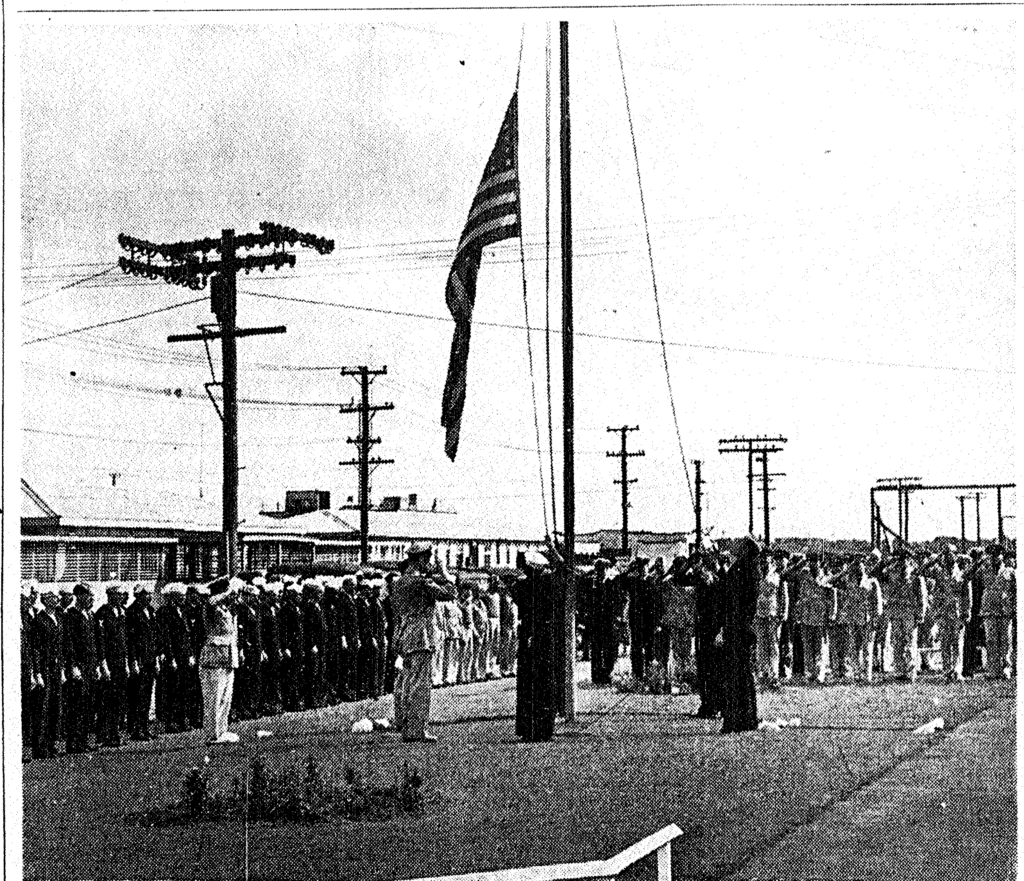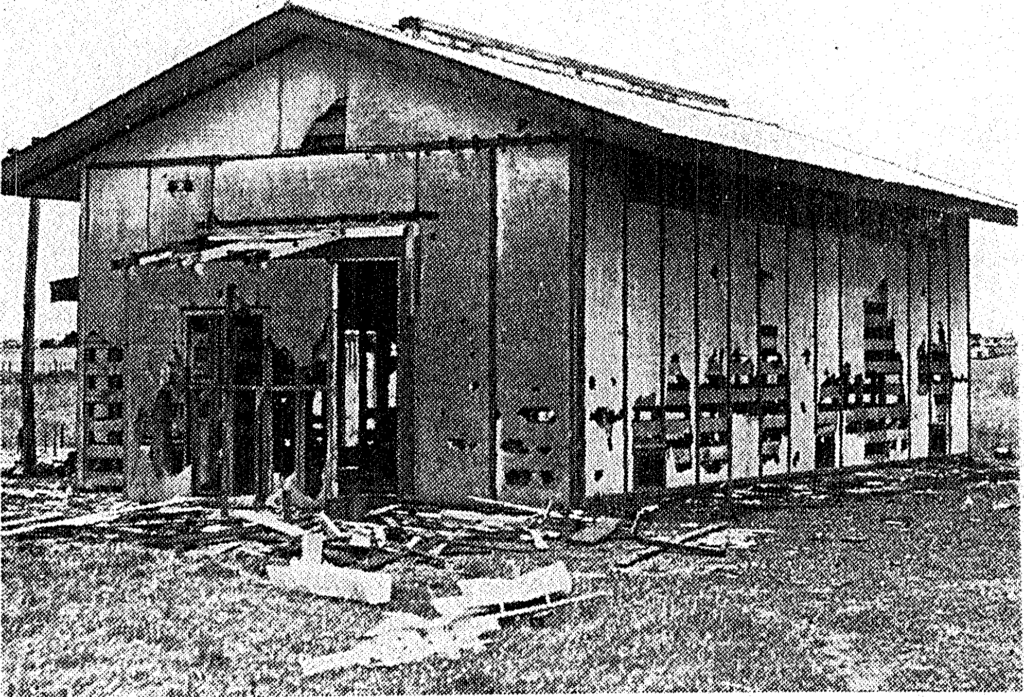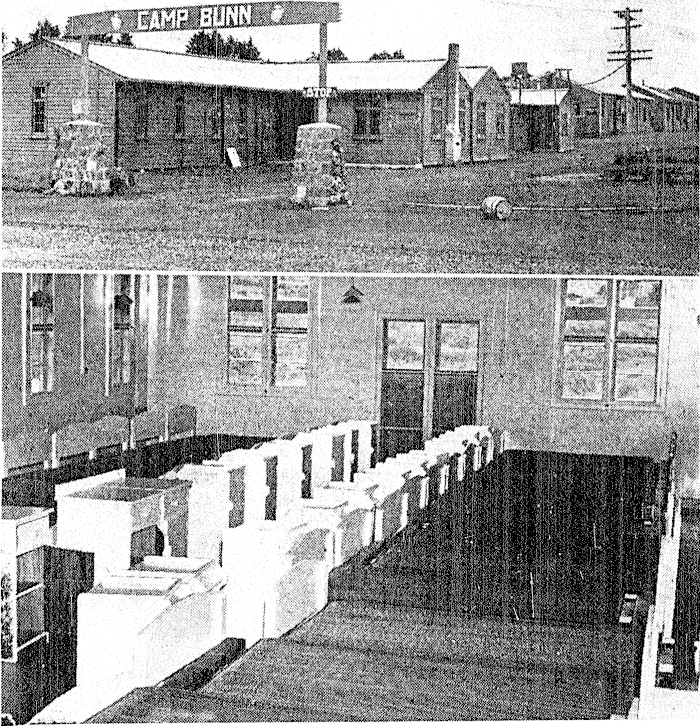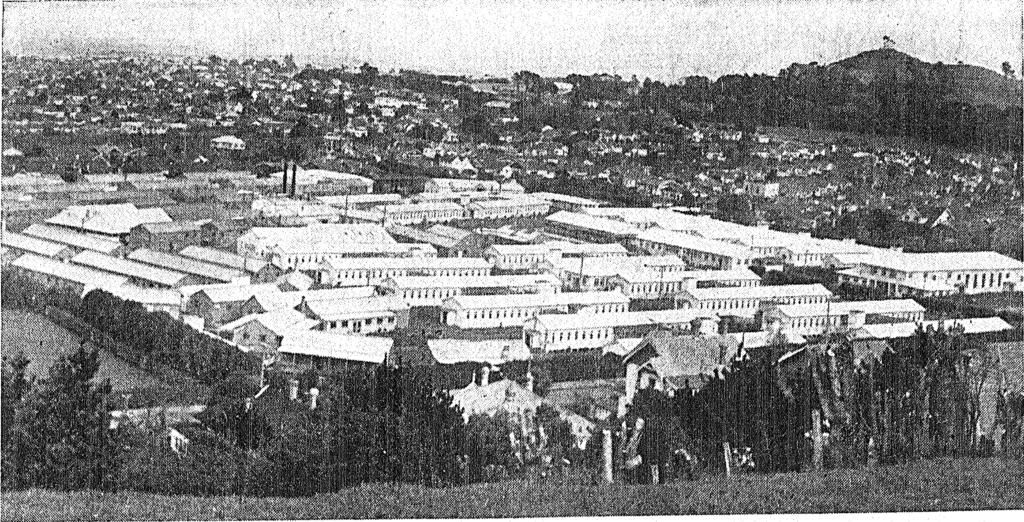|
|
Post by Dave Homewood on Apr 14, 2019 22:37:48 GMT 12
Here's a photo I just came across in the New Zealand Herald of the US Naval Hospital at Remuera. It was massive! From the NZ Herald on the 17th of June 1944:
There was also this article alongside the photo:
USE OF HOSPITALS
AMERICAN BUILDINGS
MUCH INTEREST AROUSED
Considerable interest is being taken in the disposal of many of the buildings which are expected to be vacated by the several American services from time to time in the next few months. Two which are attracting particular attention are the naval hospital in Remuera and the Army hospital at One Tree Hill. The former, which consists of about 60 buildings, all but one of which are constructed from what might be called temporary materials, is on an area formerly used as a playing field. The latter, where the many buildings are of composition sheeting finished off on the outside with a cement wash, covers several acres of the Cornwall Park reserve.
In each case the terms under which the land was leased to the Government, which built both establishments for the Americans, make it possible for the buildings to be adapted to some other purpose for a number of years to come. However, it is not likely that public opinion will allow either to be used by any New Zealand authority without protest. This is especially so in the case of the Remuera hospital, as the playing field in general was the only public recreation area in the district and in particular was the home of hockey in Auckland.
Various authorities are likely to express an interest in these two hospitals. The Rehabilitation Department is searching for a suitable vocation training centre in the city, and the Health Department might show special interest in the One Tree Hill hospital. However, the cost of maintaining this hospital as a civilian institution might be considered prohibitive, except as an emergency measure. No decision has yet been made about the disposal of the buildings in either case. It is probable that the naval hospital will be available sooner than the army hospital.
Although both hospitals are constructed of "temporary" materials, they could undoubtedly be used for many years. Both are well finished inside and both have all the normal facilities of hospitals, these including operating theatres, boiler rooms and the various necessary auxiliary buildings, including nurses' quarters and generously large recreation halls. Civilian practice would probably result in each instance in the number of beds being reduced, possibly by several hundred, and this in itself would add to the administrative cost of the hospitals as complete units.
|
|
|
|
Post by pjw4118 on Apr 22, 2019 17:22:06 GMT 12
Great to see this Dave , the field today is empty , and part of the school grounds. Some of the better buildings may have ended up as part of local transit camps . As a "temporary" solution , the One Tree Hill hospital became National Womens and lasted into the 1960s ?
If they were of MOW design they would have been bolted together as flat packs , ideal as sheds or cottages . A similar one from Hopu Hopu is owned by a mate of mine whose father in law turned it into a bach at Whangamata . Its now worth many $K.
|
|
|
|
Post by kevsmith on Apr 23, 2019 21:33:05 GMT 12
In fact before the “One Tree Hill” hospital became National Women’s it was known as “Cornwall Hospital”.
Certainly lasted until about 1975 when all the patients were transferred to Waitakere Hospital.
KS
|
|
|
|
Post by Dave Homewood on May 2, 2019 21:02:42 GMT 12
Here's another interesting photo. AMERICAN CAMP SITE NOW VACATED: A section of the barracks built in Victoria Park, Freeman's Bay, as a transit camp for United States forces, which has now been vacated. NEW ZEALAND HERALD, 20 JULY 1944  |
|
|
|
Post by pjw4118 on May 5, 2019 12:06:54 GMT 12
Thats a rare shot Dave , I have seen only one other of that camp.
|
|
|
|
Post by Dave Homewood on May 18, 2019 0:27:25 GMT 12
 "INNER DOMAIN RETURNED TO CITY COUNCIL: The camp which was erected on the inner Domain for the United States Navy has now been vacated and the area will revert to the Auckland City Council. NEW ZEALAND HERALD, 28 SEPTEMBER 1944 |
|
|
|
Post by tbf25o4 on May 18, 2019 9:59:16 GMT 12
In the second episode of the "Pacific War in Colour" which is currently showing on TV there was a series of shots taken in Auckland and one of those was looking over the hospital complex at Remuera.
|
|
|
|
Post by Dave Homewood on May 21, 2019 0:48:51 GMT 12
FAREWELL CEREMONY AT NAVAL BASE: The American flag over the headquarters at Mechanics' Bay was lowered yesterday morning when the United States Naval Operating Base in Auckland was closed. NEW ZEALAND HERALD, 23 OCTOBER 1944 
|
|
|
|
Post by davidd on May 21, 2019 9:57:41 GMT 12
Remuera of course was handed over to the RNZAF and became the main location for handling and processing all RNZAF personnel proceeding to or returning from the Pacific theatre till the end of the war. This included accommodation, storage for all blue uniform items not required overseas, messing, final medical examinations, pay action, checking of tropical kit etc, and other activities, probably including water or road transport to and from central Auckland for air or sea transport. Previously Mangere had served as the main reception area for incoming groups from overseas.
David D
|
|
|
|
Post by Dave Homewood on May 29, 2019 20:29:13 GMT 12
NEW ZEALAND HERALD, 30 NOVEMBER 1944
USE OF PARKS
WARTIME BUILDINGS
Appeal Made by Mayor
The demolition of buildings of the American naval barracks on the Domain cricket ground will be commenced by the Works Department in the near future, according to a letter received by the Mayor, Mr J. A. C. Allum, from the Prime Minister, Mr Fraser, in reply to an inquiry made before the recent announcement concerning the American hospital site in Cornwall Park. Mr Fraser adds that the delay in starting work occurred because the Auckland Education Board desired to secure certain buildings, and the demolition was held over until the board could make its selection.
Following the telegram which he sent on Tuesday, protesting against the proposed retention of the Cornwall Park site for hospital purposes for 15 years, the Mayor has written to the Prime Minister regarding the implications of the proposal and the public's attitude to it.
Concern and Uneasiness
"The proposal is causing grave concern, affecting as it does the important principle that domain and park lands are inalienable," the letter states. "It is also causing uneasiness regarding the restoration of other lands temporarily used for war purposes.
"I am particularly concerned because of the continued lack of decision regarding the occupancy of that portion of the Auckland Domain on which the soldiers' annexe to the military hospital has been built. Over the past five years I myself have had several conversations with Mr Nordmeyer and several Government officials. Although on one or two occasions I thought finality had been reached, a decision has not yet been made. A few months ago it was understood that on one of his visits to Auckland Mr Nordmeyer would further discuss the matter with me.
A Reasonable Period
"I am bound to say that I have gathered the impression that there is a desire that the soldiers' annexe shall remain for an indefinite period, and the Government's reported action in regard to the Cornwall Park area unfortunately appears to confirm this.
"From the time the first public lands were used for war purposes there has been a certain amount of criticism and dissatisfaction, much of it unjustified, but, relying on Government assurances, I have been able to say that the lands would be restored within a reasonable period after the cessation of hostilities. Fortunately, some of the public lands are about to be restored, and it is hoped that others will be restored in the relatively near future.
"I do not expect that anyone will be so unreasonable as to expect all the lands to be restored immediately on the cessation of hostilities, but there will be great discontent if any of the land is held for a period longer than is reasonable in the existing circumstances."
|
|
|
|
Post by Dave Homewood on May 29, 2019 21:44:43 GMT 12
DAMAGED MILITARY HUT: Vandals have extensively damaged this hut in Stoddard Road, Mount Roskill, which was formerly occupied by American naval personnel. NEW ZEALAND HERALD, 7 DECEMBER 1944 
|
|
|
|
Post by pjw4118 on May 31, 2019 10:27:31 GMT 12
Thats the radio station that posed where exactly questions earlier in this thread. Good find Dave.
|
|
|
|
Post by Dave Homewood on May 31, 2019 12:55:51 GMT 12
Who'd have thought we had vandals back in WWII who did things like that? These days they'd just tag it rather than kick in the asbestos sheeting
|
|
|
|
Post by Dave Homewood on Jun 23, 2019 0:09:17 GMT 12
Here's another view of the US hospital at Cornwall Park 
CORNWALL HOSPITAL LEASED AT £20,000 A YEAR: The Cornwall Hospital viewed from the slopes of One Tree Hill. Formerly known as the 39th General Hospital, the buildings were completed in 1943 at a cost of more than £566,000. All the wards are on a single floor under one roof and the communication corridors aggregate the best part of one mile. The Auckland Hospital Board has decided to accept the Government's offer to lease the hospital at a rental of £20,000 a year. NEW ZEALAND HERALD, 14 MARCH 1945 |
|
|
|
Post by Dave Homewood on Jun 24, 2019 18:17:38 GMT 12
This news review clip has some footage of the US troops at various Auckland bases
|
|
|
|
Post by Dave Homewood on Jul 11, 2019 15:03:02 GMT 12
 MILITARY CAMP MAY PROVIDE TEMPORARY HOUSING: The main entrance to Camp Bunn at Tamaki (upper) and an interior of one of the huts, showing stacked beds and pedestals. A proposal to use this camp to provide transit accommodation for 60 families is being considered by the joint committees of the Auckland Suburban Local Bodies' Association. NEW ZEALAND HERALD, 1 OCTOBER 1945 |
|
|
|
Post by davidd on Jul 13, 2019 13:40:54 GMT 12
New Zealand had some severe housing shortages at that time, and in Christchurch many of the buildings of the old Harewood RNZAF station was allocated to various sorts of refugees, including New Zealanders.
David D
|
|
|
|
Post by Dave Homewood on Jul 13, 2019 13:45:10 GMT 12
And they are still taking defence bases for housing...
|
|
|
|
Post by Dave Homewood on Jan 10, 2020 15:04:26 GMT 12
So was this the hospital at the Auckland Domain?
U.S. HOSPITAL
ONE OF THE BEST
A PERFECT SETTING
One of the finest military hospitals in the world is operated by the United States Army in New Zealand. Activated July 15, 1942, at Camp Edwards, Mass., by staff physicians and nurses from the Yale School of Medicine and School of Nursing, it has a remarkable record of only one death of each 1500 sick and battle wounded admitted, writes Captain R. S. Jackson, United States Army Relations Officer. Sheltered by giant pine, poplar, and blue-gum trees the semi-permanent buildings are surrounded by a profusion of Australian, New Zealand, American, and Indian flowers, including the fuchsia, poinsettia, red and white roses, red bougainville flowers, red, blue, and pink hydrangeas, and others, arranged in ordinary beds. Formerly many of the patients from South Pacific battle zones were sent back to the States for further treatment but because of this excellent establishment evacuations to the United States have been cut to a minimum, thereby releasing much-needed shipping for vital supplies and materials.
Because of its location in a healthful, temperate zone, and its adequate space the hospital places much stress on convalescents and one entire section of the plant has been, set aside for this important department. Areas for convalescents is a problem for many of the hospitals in the South Pacific, due primarily to the inadequacy of the humid jungle atmosphere for healing of tropical diseases and battle wounds.
SOUNDLY PLANNED.
The hospital is a model of construction. The receiving office is next to the administration building front and from this nerve centre patients are quickly dispatched to the surgical, medical, or convalescent departments. Each ward is a specialised one. Commanded by Colonel Don Longfellow, a regular army surgeon from Indiana, authority on typhoid vaccines, and a former secretary of the Army Medical School, Washington, the unit admitted its first patient on February 3, 1943. Into the hospital have come sick and wounded from all the actions in the Solomons. The latest and best medical supplies and equipment have been obtained for the hospital, which is the largest in the South Pacific area.
Rehabilitation, both spiritual and physical, is stressed by Colonel Longfellow and his staff. An abundance of wholesome food is available, including fresh eggs, milk, ice cream, fresh meat of all kinds, and raw vegetables. They are given all the fresh milk they can drink.
To assist in rehabilitation of the mind the hospital, in conjunction with the American Red Cross, has workshops, photographic darkroom, and a large gymnasium equipped for basketball. volleyball, handball, and wrestling, boxing, etc., punching bags, parallel bars, and ropes for climbing. In the workshops are tools, spinning wheels, equipment, for leather work, and instruments for carving and wood designing. There are also materials for the arts—painting, drawing, etc. An athletic field of several acres accommodates baseball, volleyball, softball, and touch football games.
The Red Cross recreation building seats more than 500. Here are table tennis, chequer, and card and a library, and movies are shown several times a week. The duty enlisted men of the hospital have similar recreational facilities, and have organised an orchestra which plays for dances held bi-weekly.
SINGING IN THE WARDS
Unique in army hospitals is a mobile piano which is transported daily from ward to ward to assist in community sings. The player is Private Dick DeArmond, who formerly had an orchestra in Toledo, Ohio. Several times monthly New Zealand civilian entertainers perform for the patients. The entire plan has been designed to facilitate the work of the medical officers in ensuring the maximum efficiency in rehabilitating patients mentally and physically so that they can return to their organisations.
All the wards present three well-windowed sides to the sunlight. Located in a quiet residential district the establishment reflects a sedate yet pleasant air. Colonel A. W. Oughterson, now consultant in surgery in the South Pacific and on leave of absence from his post as clinical professor of surgery of the Yale Medical School, had much to do with the detailed planning as acting commanding officer of the hospital. Selection of the hospital site and overall planning for the building of this hospital was accomplished prior to the arrival of this unit by Brigadier-General Earl Maxwell, army theatre surgeon.
Colonel Longfellow, who succeeded Colonel Oughterson, has one of the best medical staffs found in any hospital, whether military or civilian.
EVENING POST, 22 FEBRUARY 1944
|
|
|
|
Post by davidd on Jan 10, 2020 21:43:29 GMT 12
Maybe the one at Cornwall Park, One Tree Hill (mentioned earlier on this thread) was the Army one mentioned immediately above.
David D
|
|













